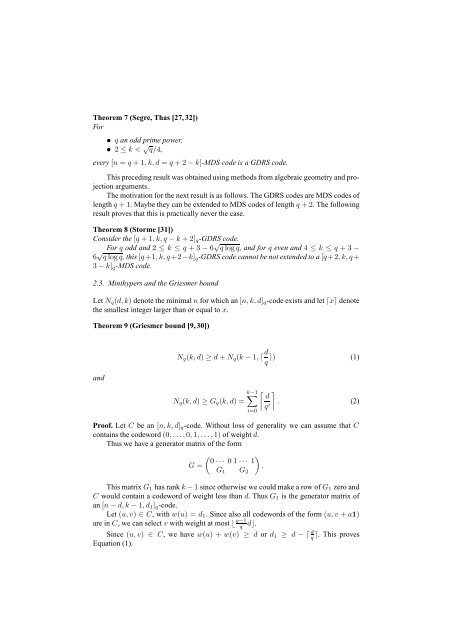Theorem 7 (Segre, Thas [27, 32])For• q an odd prime power,• 2 ≤ k < √ q/4,every [n = q + 1, k, d = q + 2 − k]-MDS code is a GDRS code.This preced<strong>in</strong>g result was obta<strong>in</strong>ed us<strong>in</strong>g methods from algebraic <strong>geometry</strong> <strong>and</strong> projectionarguments.The motivation for the next result is as follows. The GDRS codes are MDS codes <strong>of</strong>length q + 1. Maybe they can be extended to MDS codes <strong>of</strong> length q + 2. The follow<strong>in</strong>gresult proves that this is practically never the case.Theorem 8 (Storme [31])Consider the [q + 1, k, q − k + 2] q -GDRS code.For q odd <strong>and</strong> 2 ≤ k ≤ q + 3 − 6 √ q log q, <strong>and</strong> for q even <strong>and</strong> 4 ≤ k ≤ q + 3 −6 √ q log q, this [q+1, k, q+2−k] q -GDRS code cannot be not extended to a [q+2, k, q+3 − k] q -MDS code.2.3. M<strong>in</strong>ihypers <strong>and</strong> the Griesmer boundLet N q (d, k) denote the m<strong>in</strong>imal n for which an [n, k, d] q -code exists <strong>and</strong> let ⌈x⌉ denotethe smallest <strong>in</strong>teger larger than or equal to x.Theorem 9 (Griesmer bound [9, 30])N q (k, d) ≥ d + N q (k − 1, ⌈ d ⌉) (1)q<strong>and</strong>k−1∑⌈ ⌉ dN q (k, d) ≥ G q (k, d) =q i . (2)i=0Pro<strong>of</strong>. Let C be an [n, k, d] q -code. Without loss <strong>of</strong> generality we can assume that Cconta<strong>in</strong>s the codeword (0, . . .,0, 1, . . .,1) <strong>of</strong> weight d.Thus we have a generator matrix <strong>of</strong> the formG =( )0 · · · 0 1 · · · 1.G 1 G 2This matrix G 1 has rank k − 1 s<strong>in</strong>ce otherwise we could make a row <strong>of</strong> G 1 zero <strong>and</strong>C would conta<strong>in</strong> a codeword <strong>of</strong> weight less than d. Thus G 1 is the generator matrix <strong>of</strong>an [n − d, k − 1, d 1 ] q -code.Let (u, v) ∈ C, with w(u) = d 1 . S<strong>in</strong>ce also all codewords <strong>of</strong> the form (u, v + a1)are <strong>in</strong> C, we can select v with weight at most ⌊ q−1q d⌋.S<strong>in</strong>ce (u, v) ∈ C, we have w(u) + w(v) ≥ d or d 1 ≥ d − ⌈ d q⌉. This provesEquation (1).
Iterat<strong>in</strong>g Equation (1) gives:N q (k, d) ≥ d + N q (k − 1, ⌈ d q ⌉)≥ d + ⌈ d q ⌉ + N q(k − 2, ⌈ d q 2 ⌉).k−2∑⌈ ⌉ d≥q ii=0k−1∑⌈ ⌉ d≥q i .i=0+ N q (1, ⌈ d ⌉)qk−1 Now we want to construct l<strong>in</strong>ear codes that meet the Griesmer bound, i.e. we are<strong>in</strong>terested <strong>in</strong> [G q (k, d), k, d] q -codes.By θ k = qk −1q−1 , we denote the number <strong>of</strong> 1-dimensional subspaces <strong>of</strong> Fk q , i.e. thenumber <strong>of</strong> po<strong>in</strong>ts <strong>in</strong> PG(k − 1, q).The simplex code S k is a [θ k , k, q k−1 ] q -code whose generator matrix is formed byθ k pairwise l<strong>in</strong>early <strong>in</strong>dependent vectors <strong>in</strong> F k q. For each t, the copy <strong>of</strong> t simplex codesis a [tθ k , tk, tq k−1 ] q -code that satisfies the Griesmer bound.An excellent way to construct more l<strong>in</strong>ear codes satisfy<strong>in</strong>g the Griesmer bound isto start with a copy <strong>of</strong> t simplex codes <strong>and</strong> delete columns <strong>of</strong> the generator matrix. Thecolumns to be deleted form the generator matrix <strong>of</strong> what is called an anticode. This isa code with an upper bound on the distance between its codewords. Even the distance 0between codewords is allowed, i.e. an anticode may conta<strong>in</strong> repeated codewords.Def<strong>in</strong>ition 3If G is a k × m matrix <strong>of</strong> F q , then the q k comb<strong>in</strong>ations <strong>of</strong> its rows form the codewords<strong>of</strong> an anticode <strong>of</strong> length m. The maximum distance δ <strong>of</strong> the anticode is the maximumweight <strong>of</strong> any <strong>of</strong> its codewords. If rank G = r, each codeword occurs q k−r times.If we start with t copies <strong>of</strong> the simplex code <strong>and</strong> delete m columns that form ananticode with maximum distance δ, we obta<strong>in</strong> a [tθ k − m, k, tq k−1 − δ] q -code.Codes meet<strong>in</strong>g the Griesmer bound <strong>and</strong> their anticodes have a nice geometrical <strong>in</strong>terpretation.Let C be an [n, k] q -code with generator matrix G. Each column <strong>of</strong> the generatormatrix describes a po<strong>in</strong>t <strong>of</strong> PG(k − 1, q). We represent C by the multiset M <strong>of</strong> these npo<strong>in</strong>ts.For <strong>in</strong>stance, the simplex code S k is represented by the po<strong>in</strong>t set <strong>of</strong> PG(k − 1, q).An i-po<strong>in</strong>t is a po<strong>in</strong>t <strong>of</strong> multiplicity i. For each subset S <strong>of</strong> PG(k − 1, q), we denotethe number <strong>of</strong> po<strong>in</strong>ts <strong>of</strong> M <strong>in</strong> S by c(S). Letγ i = max{c(S) | S is a subspace <strong>of</strong> dimension i} .□
















